20th-century home trends: which ones did you love or hate?
A home through time

Fox Photos / Hulton Archive / Getty Images
From interior design trends of the 1920s to the introduction of the home computer in the 1990s, the ordinary family home rapidly changed in the 20th century.
Read on to take a look at what our homes looked like way back when...
The 1920s
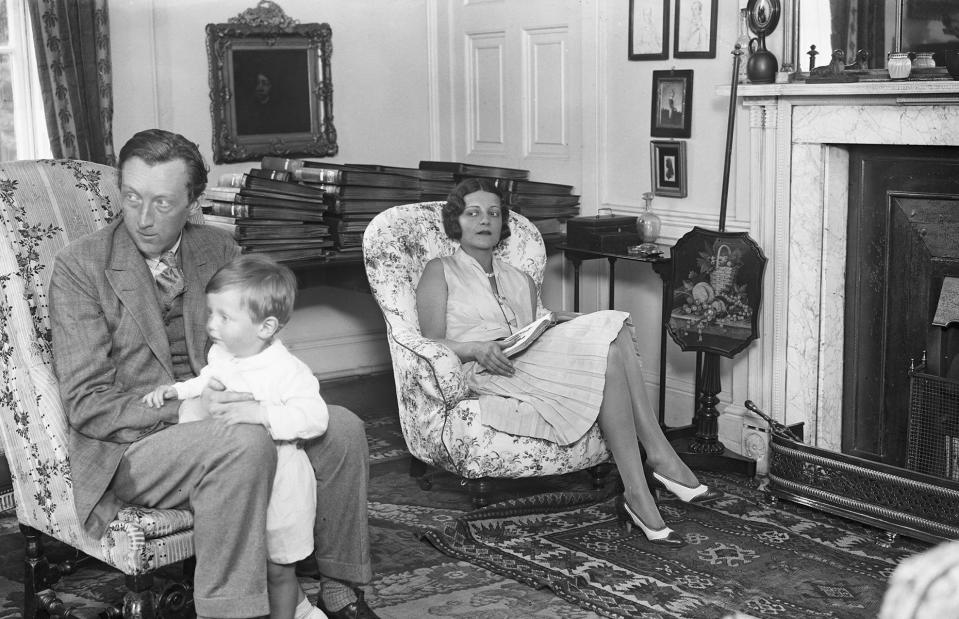
Fox Photos / Hulton Archive / Getty Images
Many people in the 1920s would not have had indoor bathrooms and furniture would have been handmade before mass production methods were around. It was also the beginning of modernity as we know it, and the taste for Victoriana soon became eclipsed by Art Deco and a desire for clean design in the home.
Electricity also became widespread in the US. In 1920 just 35% of US households had it, but by 1929 this had risen to around 70%. The UK lagged behind, with just 6% of households having electricity in 1920. It wasn't until the end of the 1930s that the figure rose to around 66%.
The 1920s house

kinkkk / Shutterstock
After the First World War, it was a boom time for housebuilding and home design catalogues became a popular way to choose a brand new property.
Colonial styles with European heritage such as Dutch Colonial, Greek Revival and English style were extremely popular and would often include columns, shutters and gabled roofs in their designs.
1920s: the living room
![<p>National Library NZ on The Commons / Wikimedia Commons [Public domain]</p>](https://s.yimg.com/ny/api/res/1.2/GdzeG_KnTVjzpY__irobvQ--/YXBwaWQ9aGlnaGxhbmRlcjt3PTk2MDtoPTYxOQ--/https://media.zenfs.com/en/loveproperty_uk_165/3bd398bef86293795215f24275024afb)
National Library NZ on The Commons / Wikimedia Commons [Public domain]
A comfortable living room was at the heart of any modern home floor plan and it would have generally had a fireplace as its focal point. Rich colours were used frequently in 1920s interior design; greens, reds, yellows, blues and purples would often be freely mixed.
With the dawn of Art Deco, there was an appetite for modern fashion including exotic prints and patterns. Floors were generally wooden or tiled and large colourful rugs would be used for warmth and comfort.
1920s: the kitchen
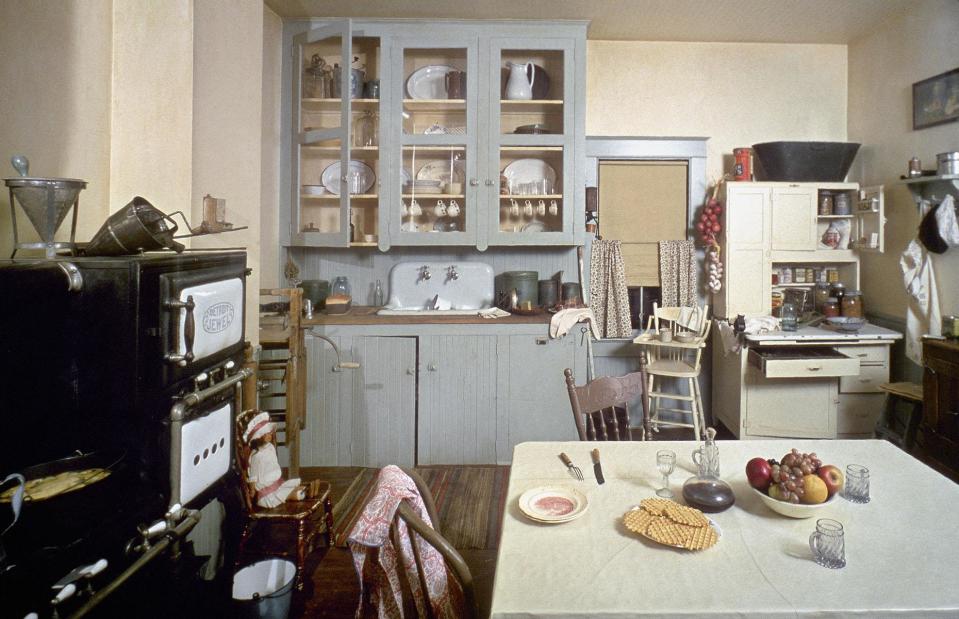
GRANGER - Historical Picture Archive / Alamy Stock Photo
Depending on how affluent a person was, they might have had a kitchen similar to this one in the 1920s.
Fitted kitchens were only just invented in 1926 and most culinary spaces were formed from cabinets, shelving and a good sturdy wooden table. Food would have been cooked on a wood-burning or oil stove and preserved in a pantry, pre-refrigeration.
1920s: the bedroom
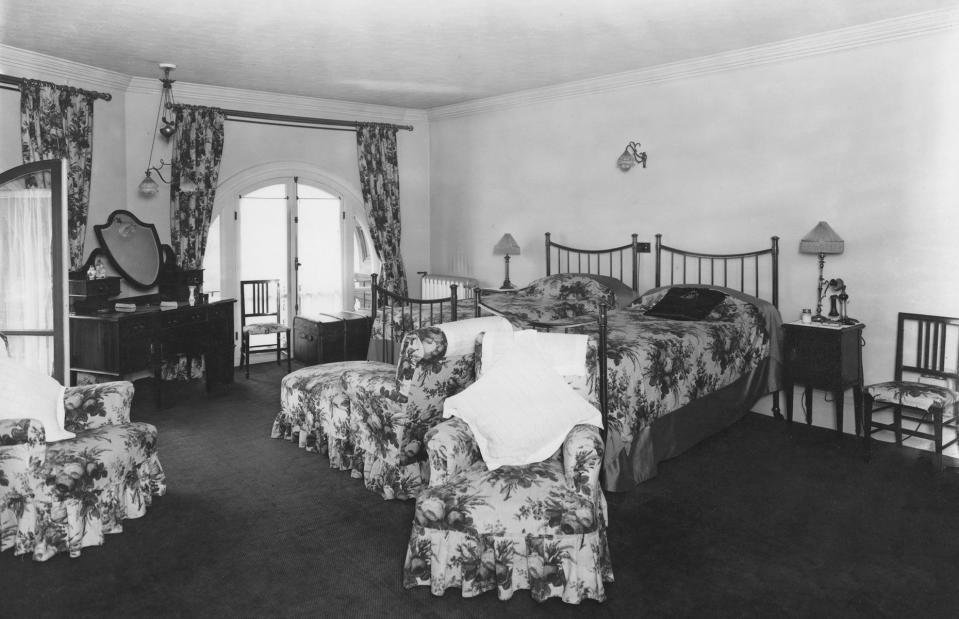
Hawkins / Topical Press Agency / Hulton Archive / Getty Images
Back in the 1920s, it was not uncommon to see twin beds in a couple's bedroom, though they might well be pushed together.
An economic boomtime, bedrooms were an expression of a newfound taste for luxury in the home and sumptuous soft furnishings and fine furniture sets were brought in to set the tone.
1920s: the bathroom

GraphicaArtis / Getty Images
The 1920s saw a shift towards better cleanliness and most people went from bathing once a week to more frequent ablutions. Bathrooms became much more important to potential homeowners and architects began to integrate them into new home plans. They were still smaller than we're used to today and showers were almost unheard of.
Tiles, wallpaper and mirrors were used decoratively to keep the place clean and splashproof, while wall-mounted sconces around the mirror over the sink would often have served as a vanity.
The 1930s
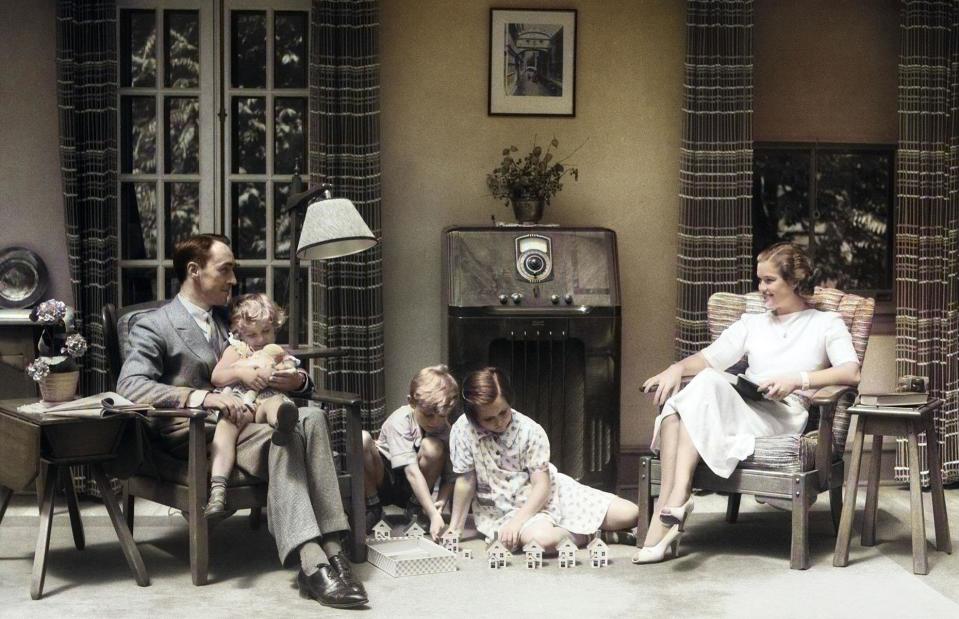
H. Armstrong Roberts / ClassicStock / Getty Images
The 1930s is often associated with glamour, but it was a time of great scarcity for most ordinary families following the Wall Street Crash of 1929. In the Great Depression that followed, more than 15 million employable Americans were out of work and the consumer economy ground to a halt.
Times were hard but those who could afford it would splash out on the latest fashions and interior trends for their homes. Ivory, beige and metallics were used prominently and modernism came into full force, with clean lines and geometric shapes becoming all the rage.
The 1930s house
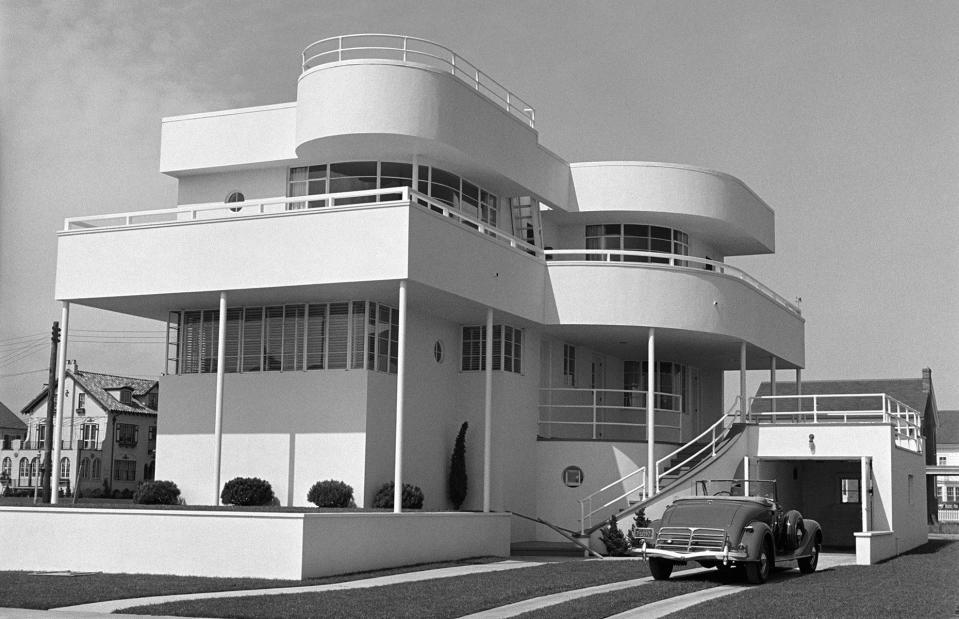
H. Armstrong Roberts / Retrofile / Getty Images
The 1930s was the decade that Art Deco turned into Art Moderne and streamlined curves were the coolest thing you could have in your home. It was another decade of intense home building by individuals with DIY home kits, while architects let their creativity run wild on creating stylish abodes that embodied the age.
Stucco was a firm favourite, delivering a smooth surface and crisp finish to highlight geometric shapes. Driveways were becoming increasingly common as more people bought their own cars, though these were still very much a luxury!
1930s: the living room
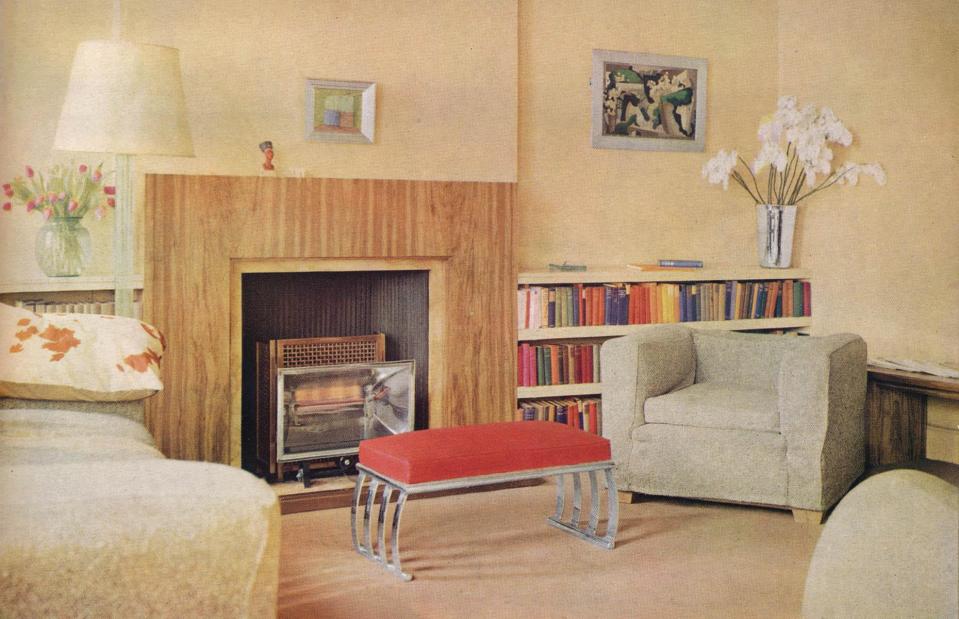
The Print Collector / Getty Images
The 1930s saw garish bright colours swapped for muted tones in pale green, beige and pastel pink.
The dawn of mass production brought more futuristic materials into the home like chrome and plastic, while shiny furniture began to creep in too. Geometric prints, inspired by exotic and often 'oriental' influences were used in fabrics and soft furnishings.
1930s: the kitchen
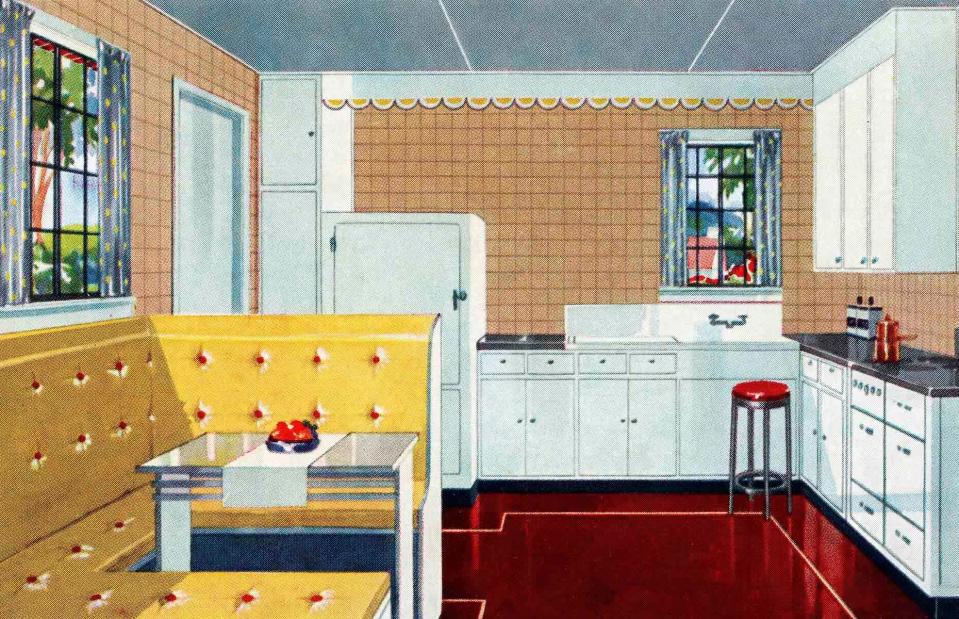
GraphicaArtis / Getty Images
As fewer people had domestic help anymore and the average woman spent more time in the kitchen, designers began to really pay attention to this previously neglected space. Like many aspects of modern design, the concept of a fitted kitchen originated in the German Bauhaus movement and by the 1930s it was the must-have feature in any new home.
The decade's obsession with curves also influenced the shape of the cabinetry, with some worktops rounded off at the ends to give it that Art Deco look. Sinks and appliances were fitted seamlessly and counters maintained the same height throughout.
1930s: the bathroom

Sasha / Hulton Archive / Getty Images
Luxury was the name of the game in a 1930s bathroom. Marble and brass were used extensively to create a sumptuous bathing space. Clawfoot baths were – for the most part – banished in favour of streamlined tubs that nestled into corners to maximise space.
1930s: the bedroom
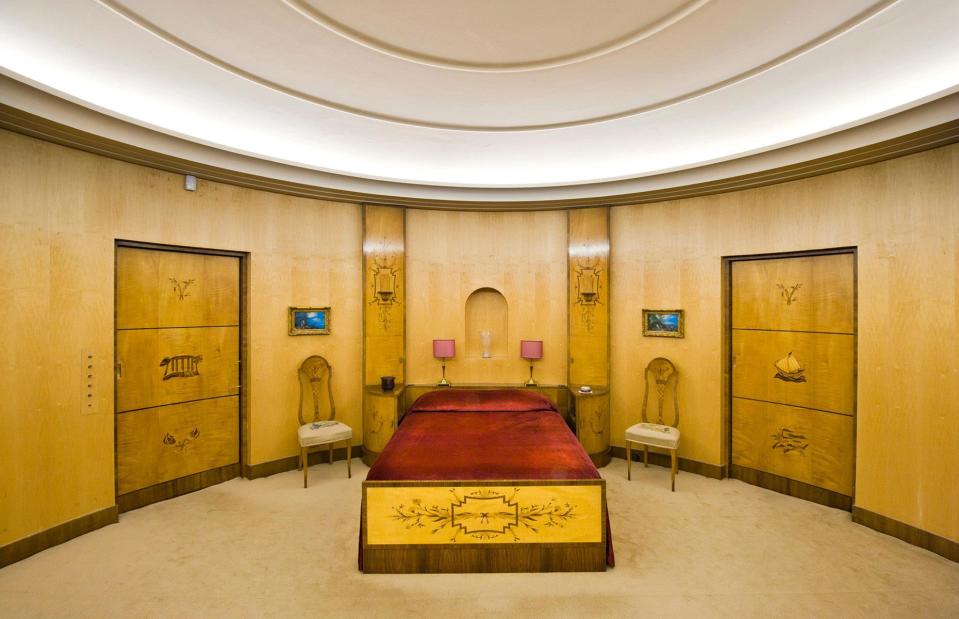
Heritage Image Partnership Ltd / Alamy Stock Photo
The bedroom really became a boudoir during this decadent decade. Curved shapes were introduced in furniture, lighting and sometimes even the walls themselves!
But the 1930s were also a time when the Arts and Crafts movement was still exerting its influence, allowing beautiful materials such as warm wood to shine in the home.
The 1940s
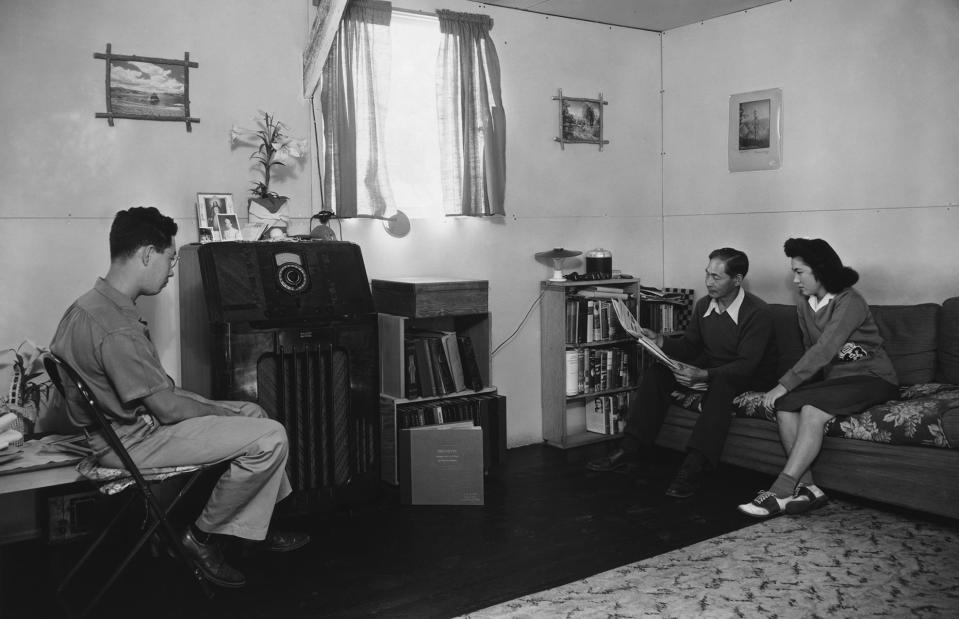
Buyenlarge / Getty Images
The effects of the Second World War were felt deeply in everyday life.
By 1942 manufacturers stopped making metal furniture, refrigerators, vacuum cleaners and washing machines in order to contribute to the war effort but it was also a time when women entered the workforce and society's attitudes began to modernise.
The 1940s house

Avalon / Construction Photography / Alamy Stock Photo
With half of the 1940s taken over by the Second World War, the average house was far from affluent. 'Make do and mend' was the order of the day and with rationing and shortages still widespread on both sides of the pond, homes still bore the hallmarks of the previous decade's style.
As the war ended and the great rebuilding program began, the demand for housing increased rapidly and many new homes were built on the outskirts of towns, creating the modern suburbs.
1940s: the living room
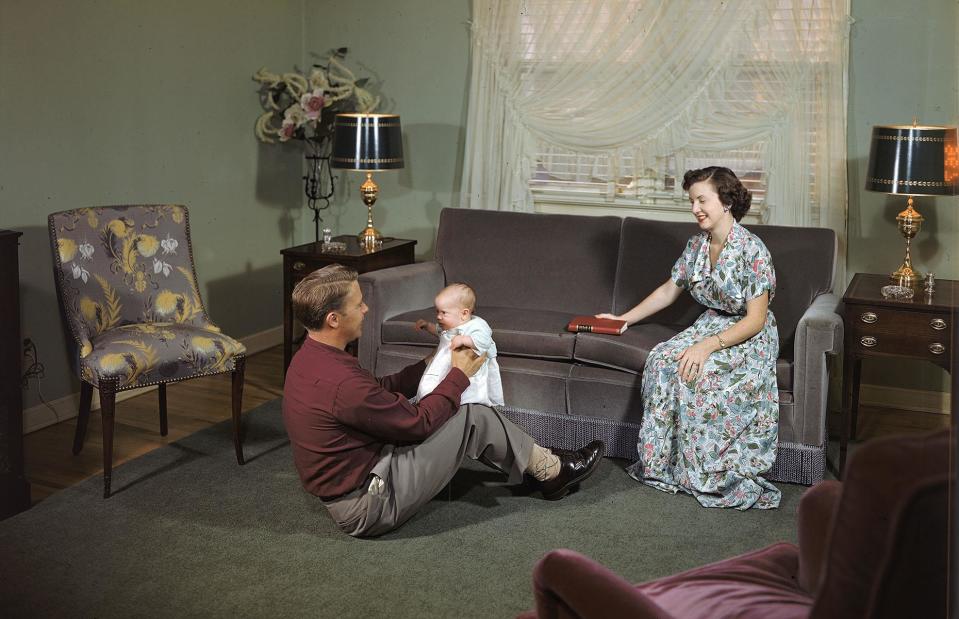
Lambert / Getty Images
With the war only coming to an end in 1945, home interiors in the first half of the decade were largely still stuck in the 30s. Properties were awash with floral prints and traditional dark wood furnishings.
In the living room, entertainment consisted of listening to the radio or record player, while a shortage of material meant old clothes and soft furnishings had to be adapted and repaired.
1940s: the kitchen

Nigar Alizada / Shutterstock
In the 1940s, kitchens were small and simple in comparison to what we’re used to today. Pastel colours and two-tone cabinets were popular, as well as brighter tones like this sunny yellow.
As more people started to own larger appliances like fridge-freezers, more spacious layouts were designed to accommodate them.
1940s: the bathroom

Hedrich Blessing Collection / Chicago History Museum / Getty Images
With a focus on cleanliness still lingering from the turn of the century, sanitaryware was typically white. Square tiles were often used to line the walls around the bath and sink, with the upper portion of the wall painted.
Linoleum was the exciting new floor covering of choice in the 1940s and the classic black and white checkerboard pattern was especially popular.
1940s: the bedroom

Hedrich Blessing Collection / Chicago History Museum / Getty Images
In this 1940s bedroom, you'll find more traditional dark wood furniture. While it's slightly more austere than pre-war furnishings, this busy floral print cheers up the room with a lively energy.
The 1950s
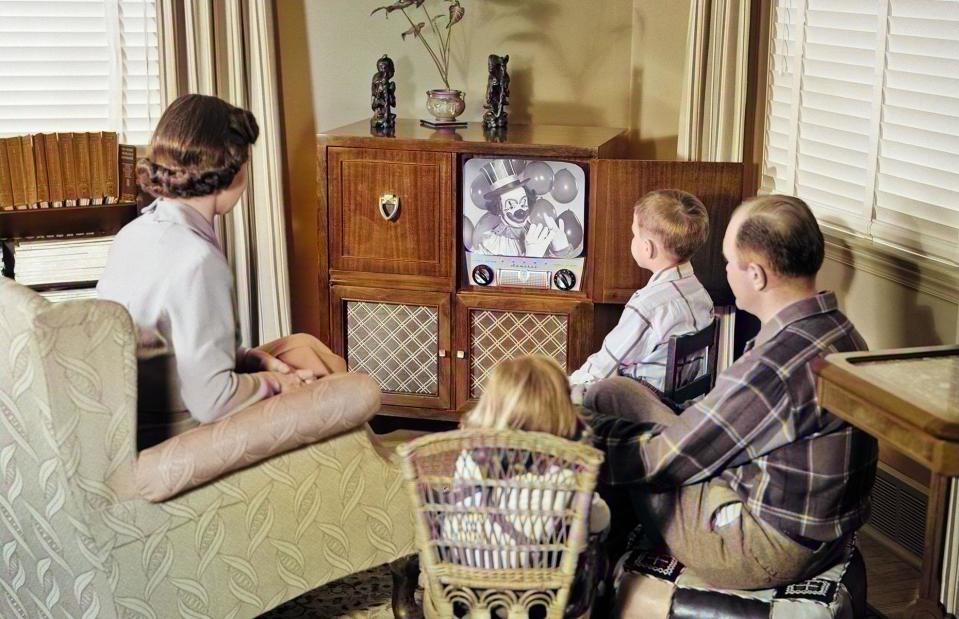
H. Armstrong Roberts / ClassicStock / Getty Images
Anyone lucky enough to be born in the 1950s would be among the early wave of ‘baby boomers’ who grew up in a prosperous and revamped society. During the 1950s, TV sets became much more common in the home, labour-saving appliances appeared in the kitchen and consumer goods were plentiful.
Homes were undergoing big changes too, with new open-plan layouts favoured and American influences felt all over the world – checkerboard floors, Formica furniture and bright colours become particularly popular.
The 1950s house
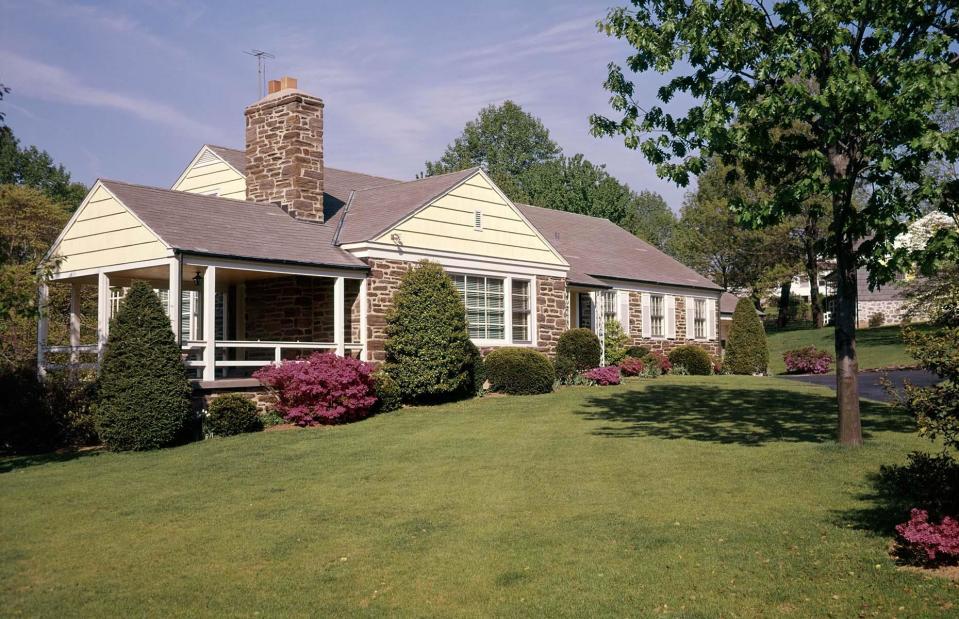
ClassicStock / Alamy Stock Photo
In the 1950s, the economic picture was much rosier than in the previous decade. It was a boom time for industry and consumer wealth, which spurred on great leaps in terms of design and modern tastes.
House building moved away from traditional styles to more modernist designs, with clean angular lines, swathes of windows and sliding glass doors to draw the outside in. House facades from this era tended to feature very little ornamentation and outdoor space becomes more polished.
1950s: the living room
![<p>Italo Greco / Wikimedia Commons [CC BY 2.0]</p>](https://s.yimg.com/ny/api/res/1.2/ehdJ3934UpZR8QGHpDJewA--/YXBwaWQ9aGlnaGxhbmRlcjt3PTk2MDtoPTYxOQ--/https://media.zenfs.com/en/loveproperty_uk_165/6d423b0adb763661d20092ff477fa8a2)
Italo Greco / Wikimedia Commons [CC BY 2.0]
In the 1950s, the living room was where everyone listened to music, watched TV, spent time with their family and entertained guests.
Typically, the colour palette consisted of pastel hues, with bold shades incorporated across accessories, like the red zigzag cushion pictured here. When it came to upholstery, heavy textures in earthy browns and greens were all the rage, while busy patterns were commonplace too.
1950s: the kitchen
![<p>Michael Barera / Wikimedia Commons [CC BY-SA 4.0]</p>](https://s.yimg.com/ny/api/res/1.2/7mLYWVY5O8jwpeJ4cO1AbA--/YXBwaWQ9aGlnaGxhbmRlcjt3PTk2MDtoPTYxOQ--/https://media.zenfs.com/en/loveproperty_uk_165/0f4bec46125cf7d8c477f8619fa6caf8)
Michael Barera / Wikimedia Commons [CC BY-SA 4.0]
This kitchen features all the essential 1950s design elements – pastel colours, Formica worktops with metal edging and appliances like toasters, electric mixers and this washing machine on wheels that emptied into the kitchen sink. In fact, by 1955, 80-90% of American households had a fridge or washing machine (compared to fewer than one in five in the UK).
In the 1940s, linoleum was a popular floor covering but manufacturers started to redesign it with bright bold patterns to make it less utilitarian.
1950s: the bathroom
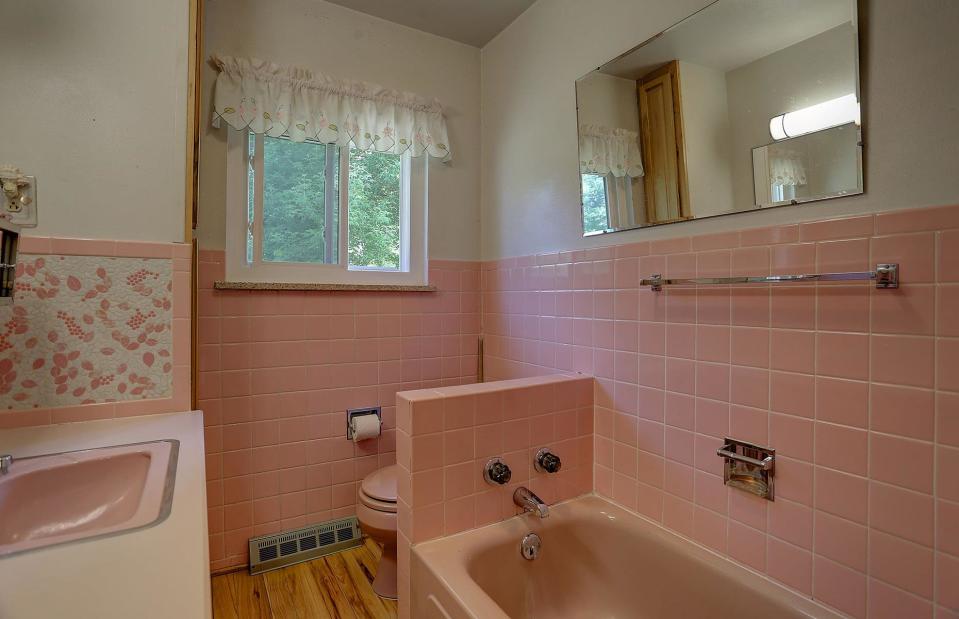
Patrish Jackson / Shutterstock
A popular hue for bathrooms, the pale pink suite was a 1950s staple.
Coloured sanitaryware in pastel shades also became fashionable at this time, a trend which continued well into the 1980s. Colour coordination was a must, while wipeable tiling found its way onto countertops and bathroom vanities.
1950s: the bedroom
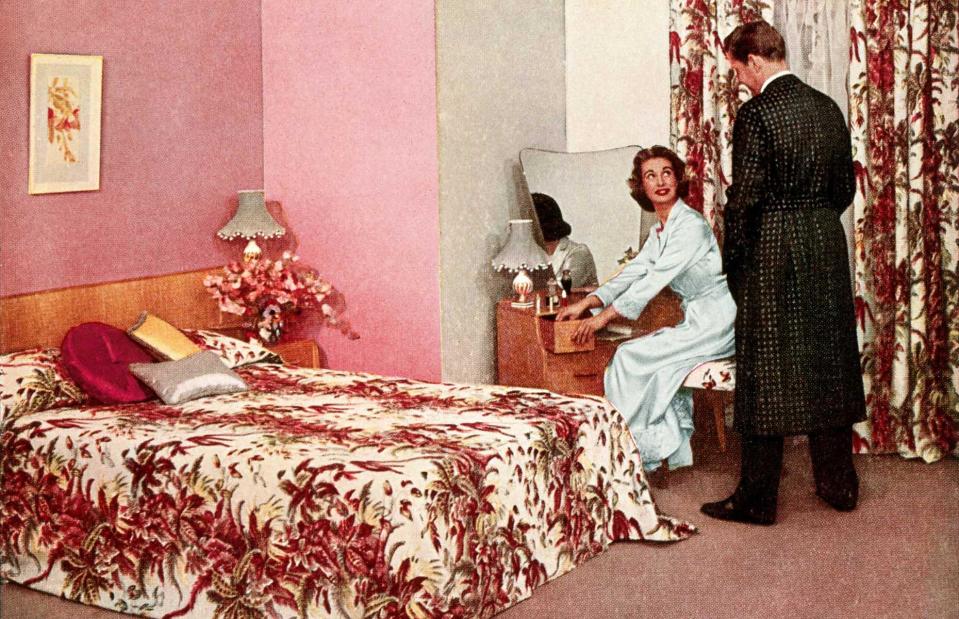
Heritage Image Partnership Ltd / Alamy Stock Photo
More prosperous than the previous decade, there was a greater emphasis on comfort in the 1950s. Bedrooms were colourful, luxurious spaces, with bold schemes and glitzy prints.
Wall-to-wall carpeting also emerged as an opulent new trend around this time. More households owned TVs too, so entertainment was at the fingertips of homeowners like never before.
The 1960s
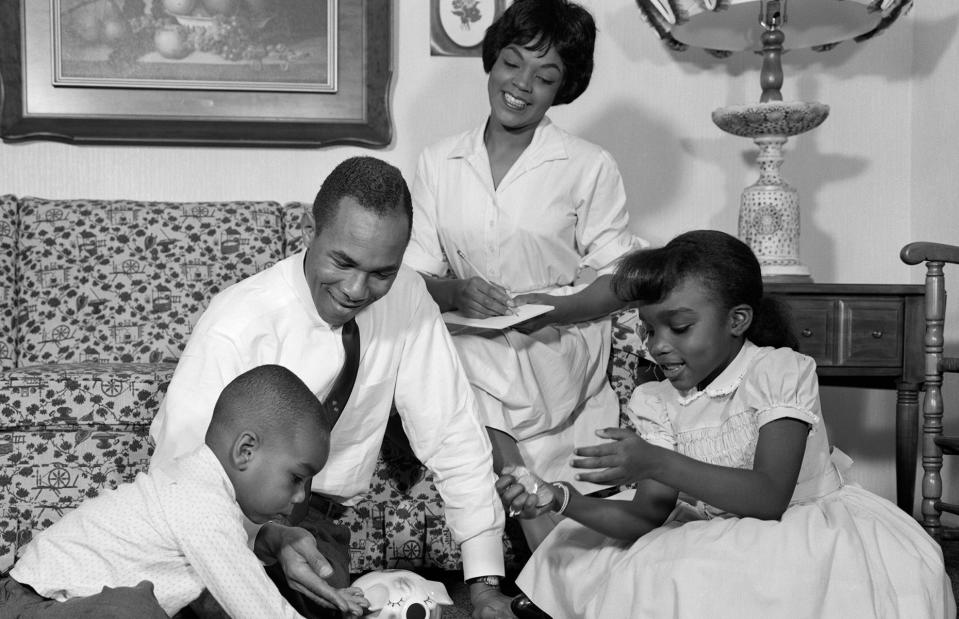
H. Armstrong Roberts / ClassicStock / Getty Images
After 1963, society changed dramatically as cultural, political and economic forces swept away the buttoned-up rules of the previous decade. The swinging 60s meant that the home and interiors also became supercharged with colour and many of the comforts we recognise today.
Women were beginning to enter the workforce in earnest, while many people moved into apartments, flats and condos as new buildings shot up. Plastic, PVC and space-themed décor were on-trend, as were global throws and rugs from Morocco and India.
The 1960s house
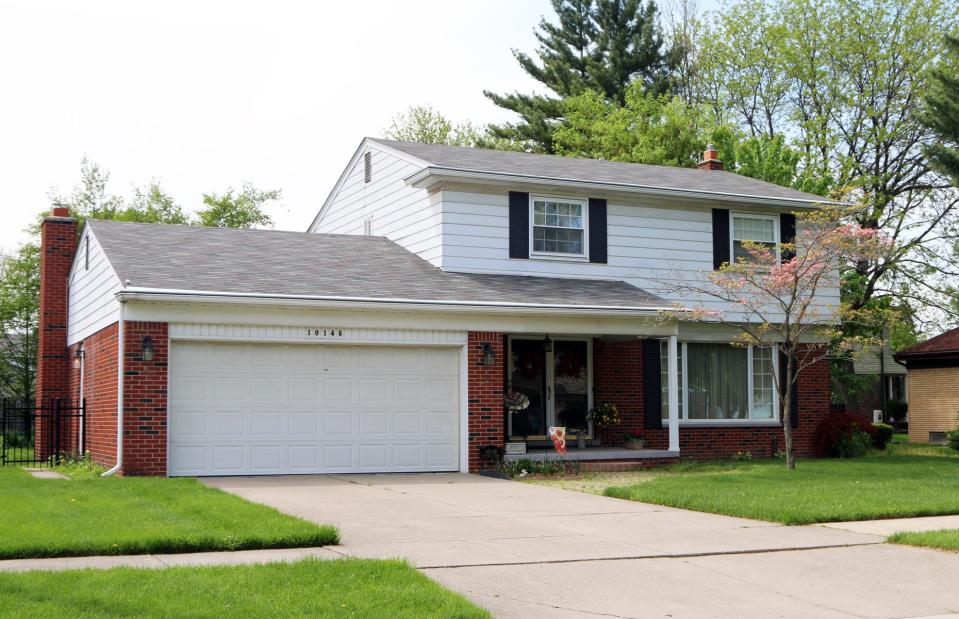
James R Martin / Shutterstock
Smart new build houses like this became a common sight in the 60s. These designs borrowed from the traditional styles of the past but came with shiny new modern additions.
As suburbs grew, cars were increasingly relied upon for day-to-day life, so this house has a built-in double garage and concrete driveway.
1960s: the living room
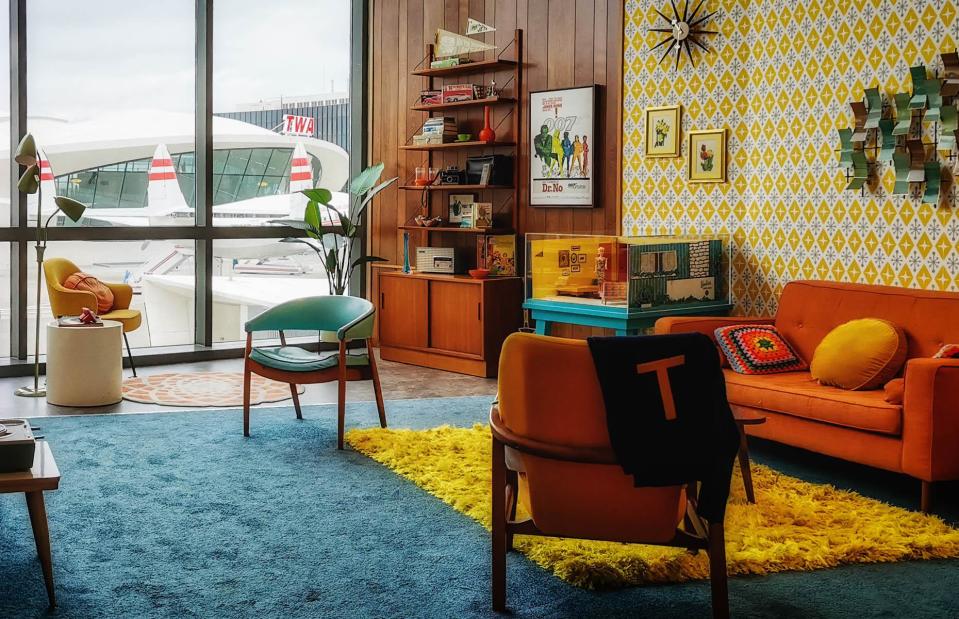
Atosan / Shutterstock
The 1960s was a time of cultural revolution and change, reflected in a vibrant new interior style. If you were around in this psychedelic decade, your home would've been transformed with an array of bright colours and the new obsession with long-pile carpets.
Modern Scandinavian furniture was also in vogue, which influenced the architectural shape of this furniture.
1960s: the kitchen
![<p>Seattle Municipal Archives / Flickr [CC BY 2.0]</p>](https://s.yimg.com/ny/api/res/1.2/WaQJxfTI7HEwrVeaYGk6OA--/YXBwaWQ9aGlnaGxhbmRlcjt3PTk2MDtoPTYxOQ--/https://media.zenfs.com/en/loveproperty_uk_165/e9a8194db4f28b0b74c630f0038dd66d)
Seattle Municipal Archives / Flickr [CC BY 2.0]
Kitchens from this decade would have featured sleek unfussy cabinets and laminate or Formica worktops, often with built-in accessories.
New-fangled kitchen appliances for entertaining became popular, such as rotisserie ovens and electric coffee makers.
1960s: the bathroom
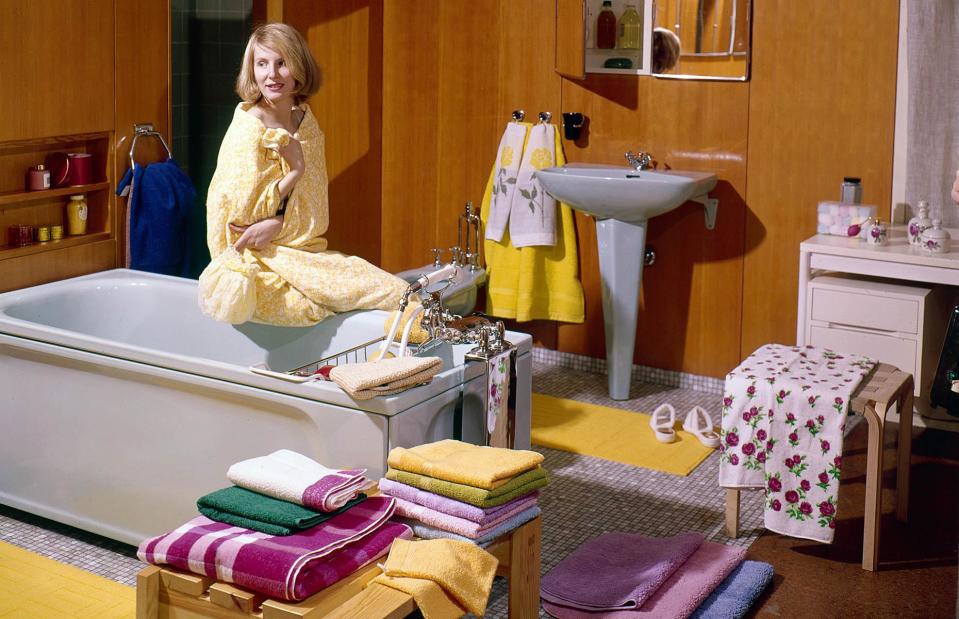
Classic Picture Library / Alamy Stock Photo
Bold colours continued into the 1960s bathroom. Showers, as well as baths, became a more common choice for homeowners.
This was also the age of fluffy bathroom rugs – usually one in front of the bath and the sink, with another around the toilet. Many might remember the fluffy tissue box cover with fondness – or a shudder – too.
1960s: the bedroom
![<p>Smilow-Thielle via 1950sUnlimited / Wikimedia Commons [CC BY 2.0]</p>](https://s.yimg.com/ny/api/res/1.2/1wo6xG7Qh4D.e.BwRU6LZQ--/YXBwaWQ9aGlnaGxhbmRlcjt3PTk2MDtoPTYxOQ--/https://media.zenfs.com/en/loveproperty_uk_165/32f978c56e721e2b606fe6448235f1ec)
Smilow-Thielle via 1950sUnlimited / Wikimedia Commons [CC BY 2.0]
Sleek mid-century furniture like this became enormously popular in the 1960s, as did pops of colour, supplied by these decorative cushions.
As homes expanded so too did the luxury of built-in storage. Bedrooms often featured bespoke wardrobes and cupboards – perfect for hanging groovy miniskirts and flared trousers.
The 1970s
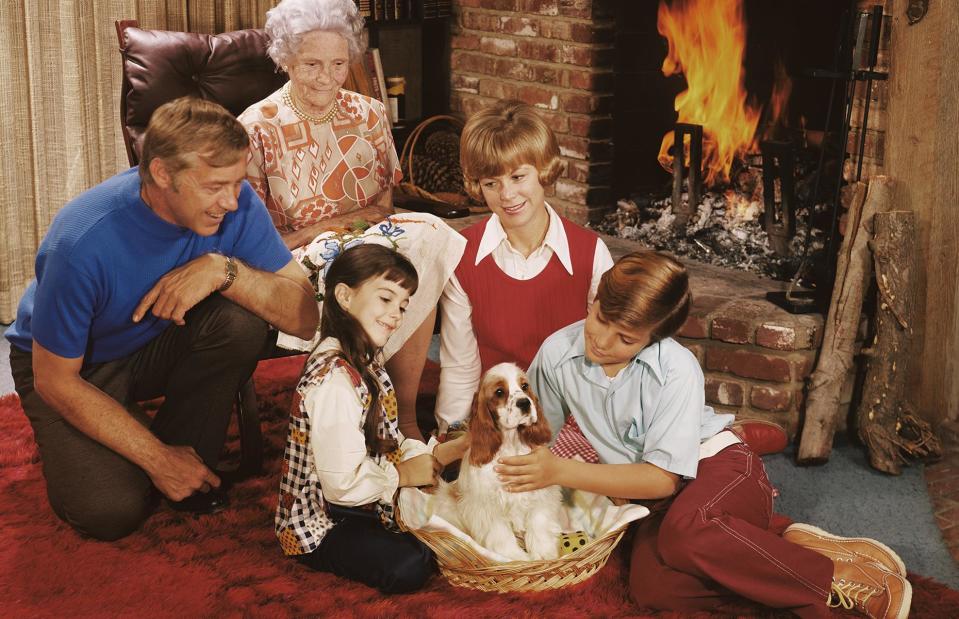
Fox Photos / Hulton Archive / Getty Images
Aside from big hair and even bigger bell-bottoms, the home was influenced by advancements in electronics, with a microwave oven in the kitchen and even some early Atari computers.
New housing was in development between the 1960s and 1980s, resulting in modern builds that were ripe for decorating. Colour TVs were showing the first wave of home improvement programmes and the desire to decorate went mainstream.
The 1970s house
![<p>Guhbear / Wikimedia Commons [Public domain]</p>](https://s.yimg.com/ny/api/res/1.2/mEgJxFcIllp7.s3LQxViyA--/YXBwaWQ9aGlnaGxhbmRlcjt3PTk2MDtoPTYxOQ--/https://media.zenfs.com/en/loveproperty_uk_165/3716bfc5ed6285f3e6b30a933d0ce3b6)
Guhbear / Wikimedia Commons [Public domain]
Houses built in the 1970s tend to get a bad rep but they have a lot going for them! Big rooms, large windows and plenty of outdoor space made them fabulous family homes but some of the decorative touches are now considered design pariahs.
Very few ceilings were spared the Artex (popcorn) treatment, which sometimes contained asbestos, and cladding was in in a big way.
1970s: the living room

H. Armstrong Roberts / Retrofile / Getty Images
Orange, brown, yellow and avocado green were all go-to colours in the 70s and chrome had made a comeback too, making this room achingly chic for the period.
Exposed-brick fireplaces, wood panelling, cane furniture and long-pile carpets in vibrant colours were also major trends at the time.
1970s: the kitchen

f8 Imaging / Hulton Archive / Getty Images
Laminated kitchen cupboards and Formica worktops were a staple of the 1970s kitchen – this bright space features a sunny harvest gold, brown and white colour scheme. Bold prints – particularly on wall tiles – were all the rage.
Plenty of storage, plus the latest appliances including the first domestic dishwashers, became the new norm in the heart of the home.
1970s: the bathroom

Andrew Paterson / Alamy Stock Photo
The classic avocado bathroom suite was a much-loved staple of the decade. Here it’s paired with green and white patterned wall tiles and green carpet, although ceramic tiling was also a common choice for bathroom flooring at this time.
A fluffy toilet lid cover would also have been a familiar, if questionable, feature.
1970s: the bedroom
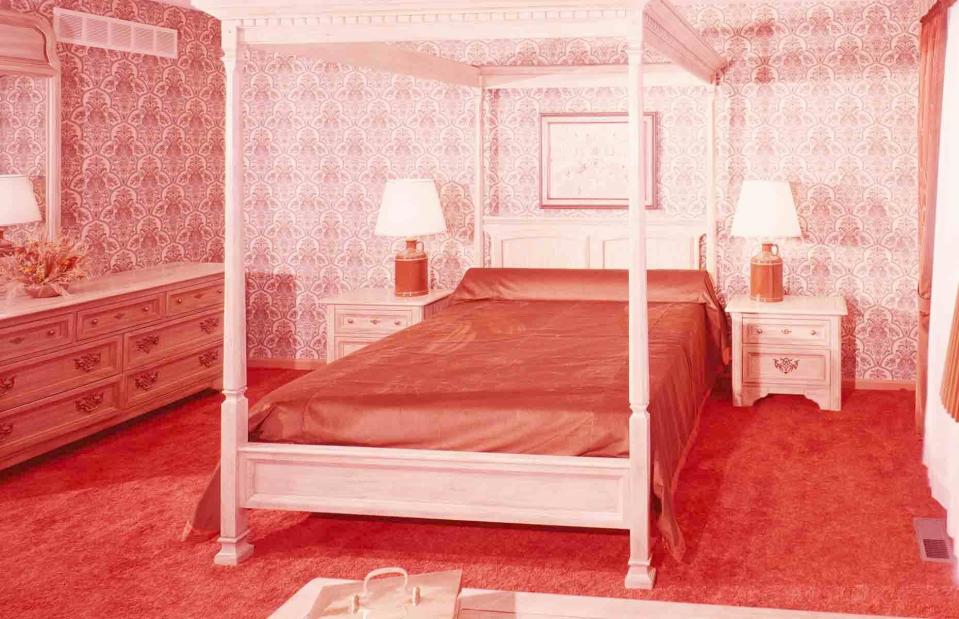
H. Armstrong Roberts / Retrofile / Getty Images
Peach and coral tones were considered glam in the 70s, as we can see from this luxurious bedroom. While the palette is limited, the boldly patterned wallpaper and vibrancy of the colours are spot on for the era and hint at the opulence to come in the 80s.
The 1980s
![<p>Bill Branson / Wikimedia Commons [Public domain]</p>](https://s.yimg.com/ny/api/res/1.2/b7YKwEUT_sMGhvjUK5t29Q--/YXBwaWQ9aGlnaGxhbmRlcjt3PTk2MDtoPTYxOQ--/https://media.zenfs.com/en/loveproperty_uk_165/12fccaf32474930df493c4ff6787c40b)
Bill Branson / Wikimedia Commons [Public domain]
For many in the West, the 1980s was a time of growing affluence. The threat of nuclear war had all but vanished as the Cold War petered out, capitalism was on the rise, interest rates fell, confidence was high and economies boomed.
House prices shot up, but wages did too, enabling people to build bigger and better houses than ever before...
The 1980s house
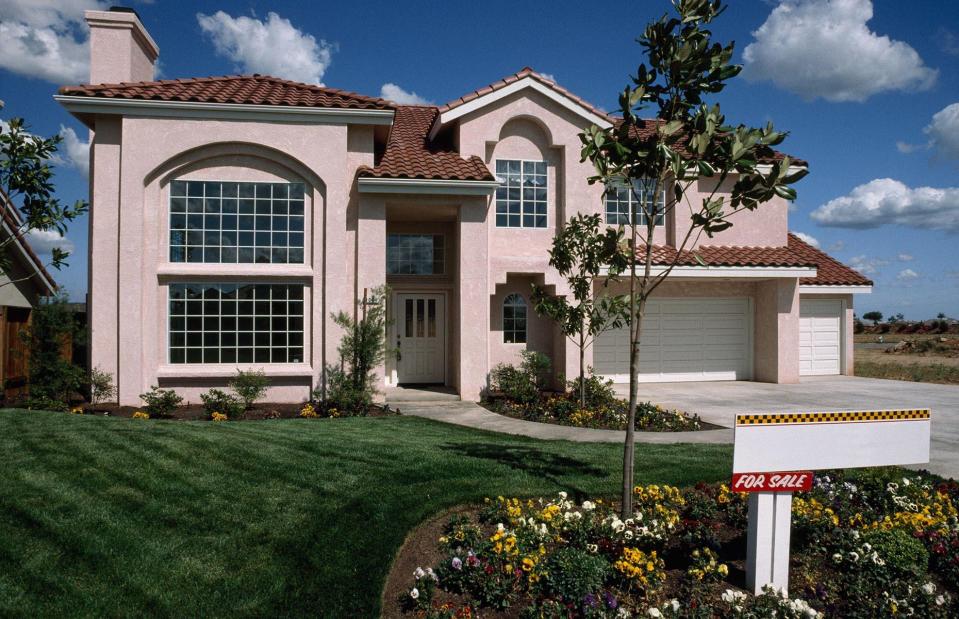
Patti McConville / Alamy Stock Photo
Demand for housing grew and 'McMansions' sprang up in suburbs everywhere. Also known as 'executive homes', they were usually mass-produced neo-eclectic homes built for the rapidly expanding upper middle class. Typically built right up to the edges of their boundaries, they often featured wide garages or driveways to accommodate two or more cars.
Quirky Postmodern architecture also flourished, as a reaction against the austerity and formality of earlier decades.
1980s: the kitchen
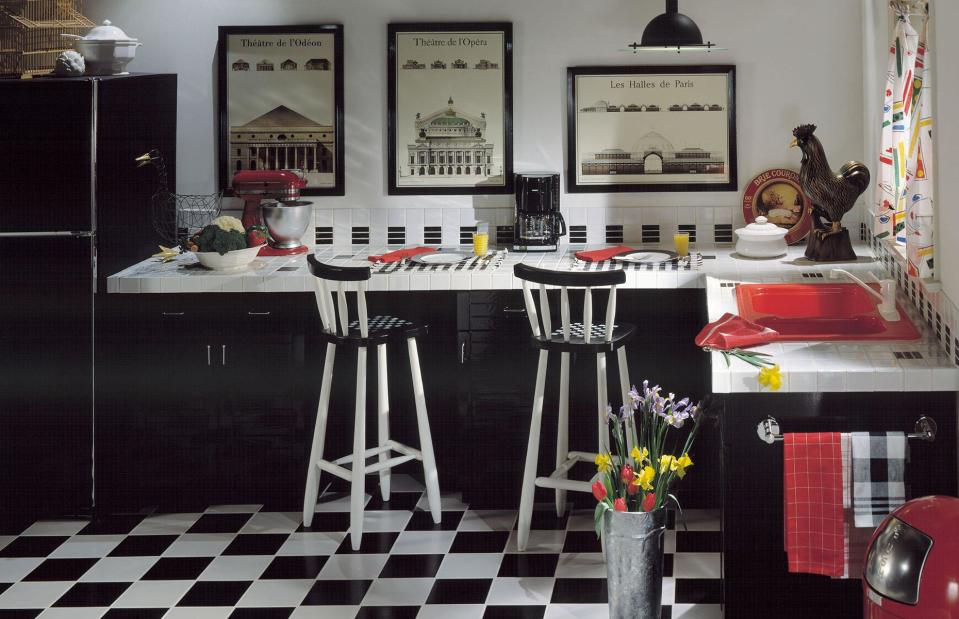
TOLBERT PHOTO / Alamy Stock Photo
Red and black colour schemes were all the rage in the 80s and a firm favourite among Yuppies (those young, upwardly mobile professionals working in new, fast-paced city jobs).
Another hot 80s kitchen style was the farmhouse kitchen. Often overly fussy with chintzy ruffles at the windows, these homey spaces embodied a quietly monied, wholesome aesthetic. Shaker cabinets, a large scrubbed pine table, decorative plates and dried flowers were must-haves.
1980s: the living room
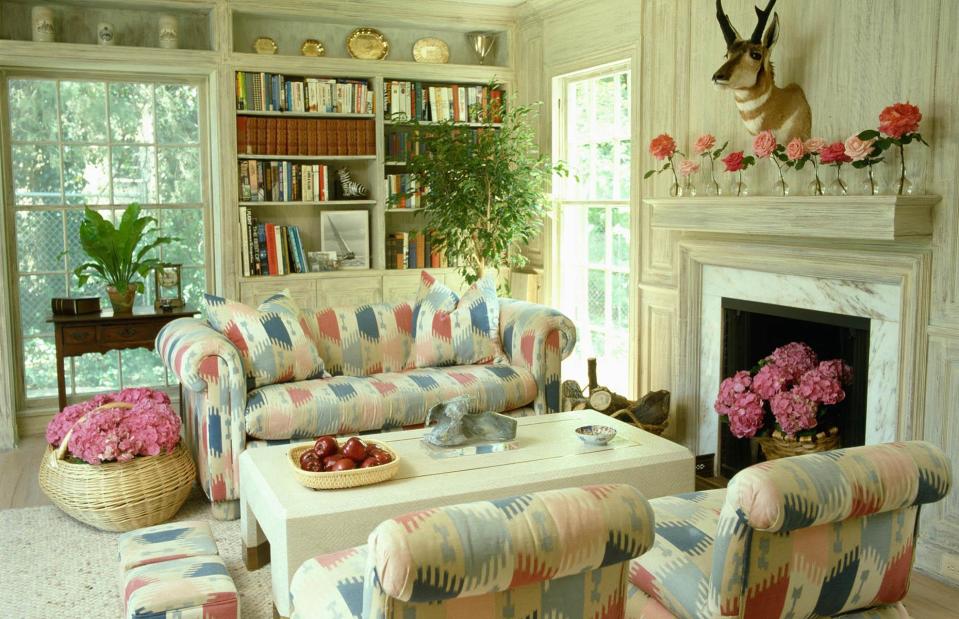
Elizabeth Whiting & Associates / Alamy Stock Photo
Going hand-in-hand with the farmhouse aesthetic, soft neutrals and pastels were a popular antidote to the loud colours and sharp edges of other 80s décor trends.
These muted shades created serene living spaces, although the soft furnishings weren't immune from invasion by 'fun' 80s prints, like this one.
1980s: the living room
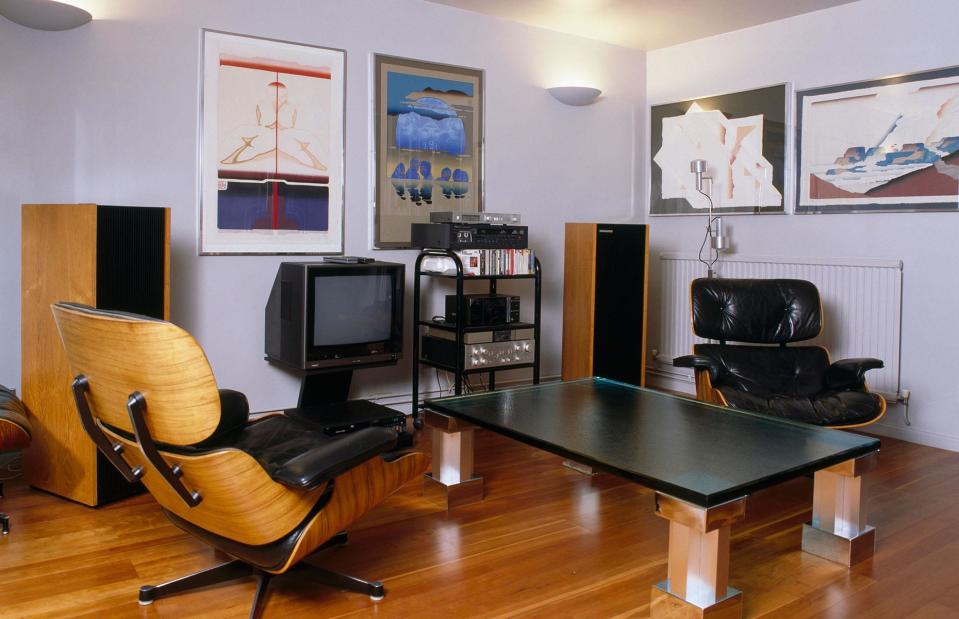
Elizabeth Whiting & Associates / Alamy Stock Photo
Bold, sharp lines and geometric shapes were the order of the day in the stylish apartments of this newly wealthy generation.
Leather and chrome were popular, and people proudly showed off their affluence by displaying the very latest home entertainment systems, not to mention expensive pieces of furniture like Eames armchairs.
1980s: the bathroom
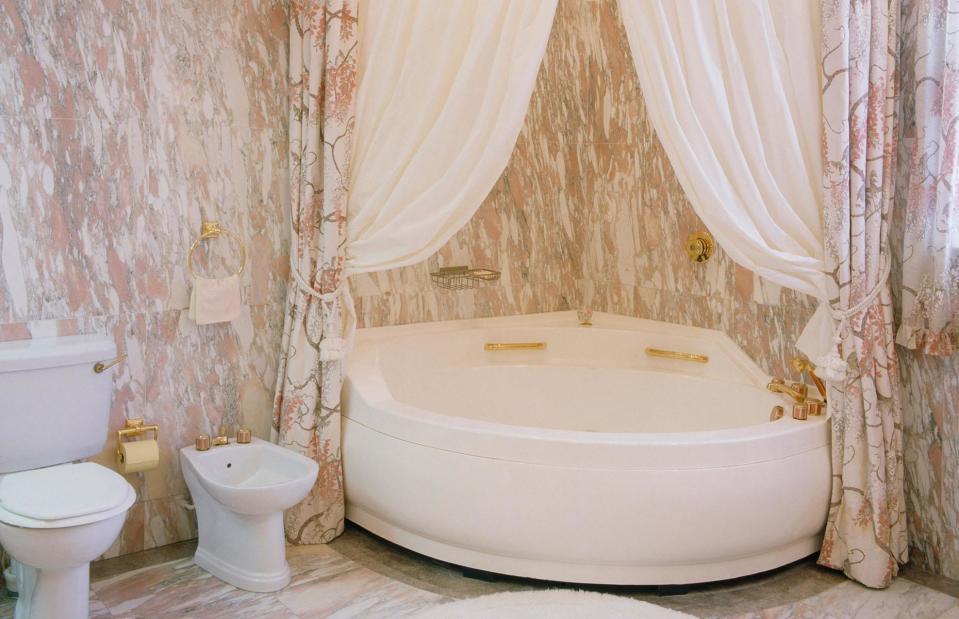
Elizabeth Whiting & Associates / Alamy Stock Photo
The 1980s was a time of high glamour, characterised by big hair, big jewellery and gold-plated everything. Even the smallest room of the house couldn't escape a glam makeover.
Marble, drapes, ruffles and shiny gold (or, more likely, brass) were bathroom essentials for fans of Dallas, Dynasty and a certain young property mogul named Donald J. Trump.
1980s: the bedroom
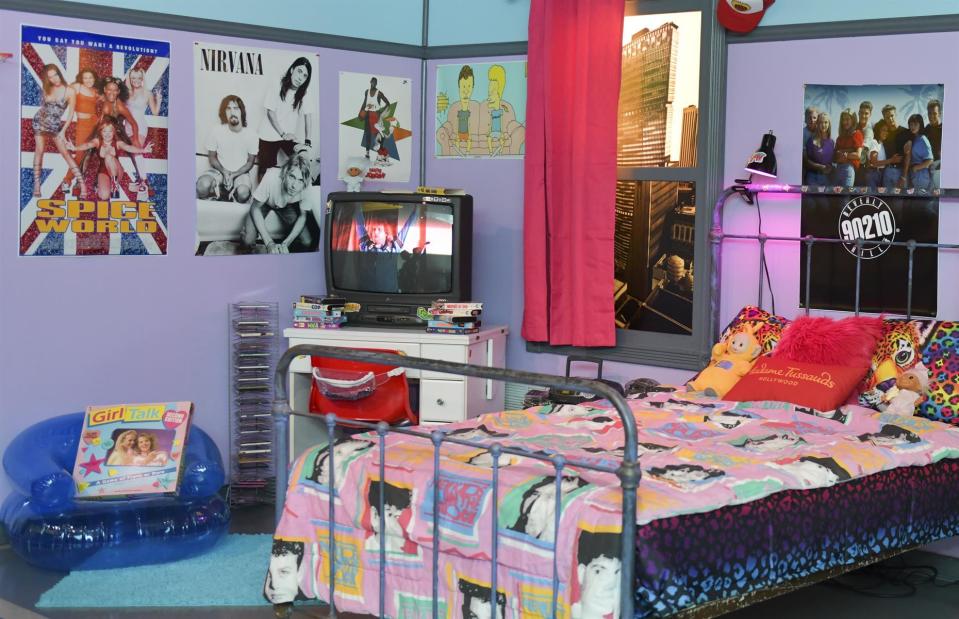
Rodin Eckenroth / Getty Images
The Memphis design style defined the 1980s like nothing else. Full of neon colours, bold shapes and eye-catching patterns, it was inspired by Art Deco and Pop Art and has been described as "a shotgun wedding between Bauhaus and Fisher-Price".
The style characterised a backlash against the status quo and as a result, it was popular among 80s youth – few teenage bedrooms escaped a hint of Memphis.
The 1990s
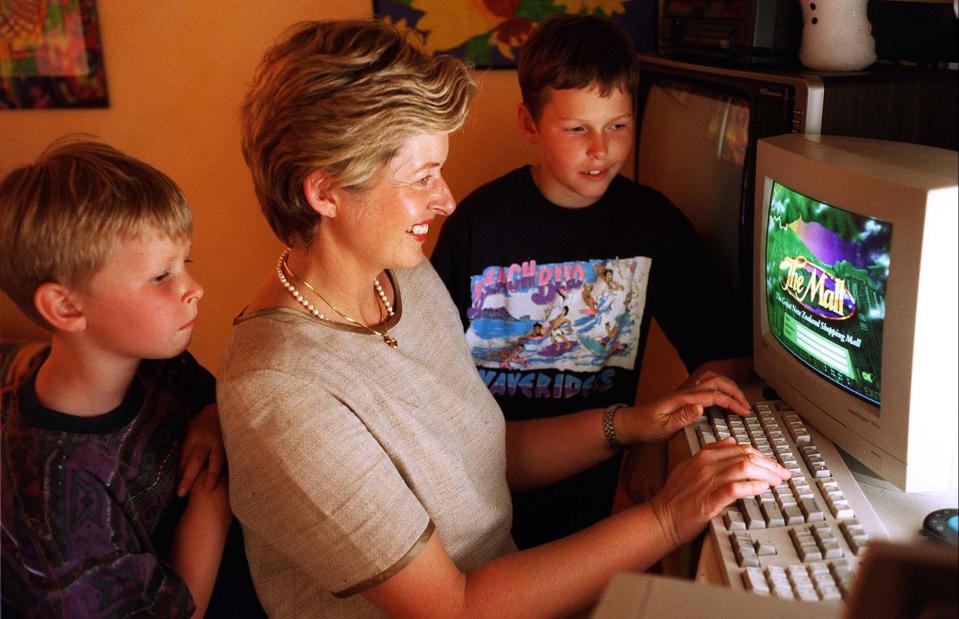
Ross Land / Getty Image
While the 1990s was a rollercoaster of a decade when it came to the economy and the impact on housing, it's most notable as the period in which many of us welcomed the first personal computers into our homes.
Clunky, chunky and not particularly pretty, these early PCs perched on a table in the family room, where everyone gathered around to endure the screech of dial-up-internet to send an email via AOL, before dabbling with Clip Art or playing Minesweeper. But what did our homes look like?
The 1990s house
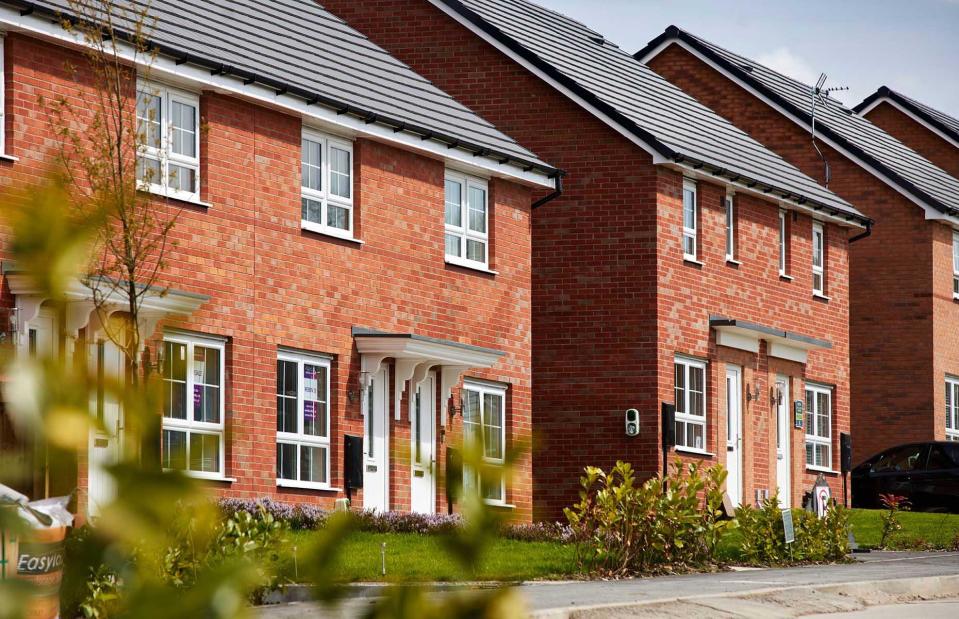
Mark Waugh / Alamy Stock Photo
While a recession in the early 1990s hit home construction, the building boom that followed in the late 90s and early 2000s saw swathes of new suburbs spring up.
In the US, Colonial Revival homes became popular, and their red-brick facades were echoed over the pond, where residential property developments – like this one – full of near-identical homes, were built at a rapid rate.
1990s: the kitchen
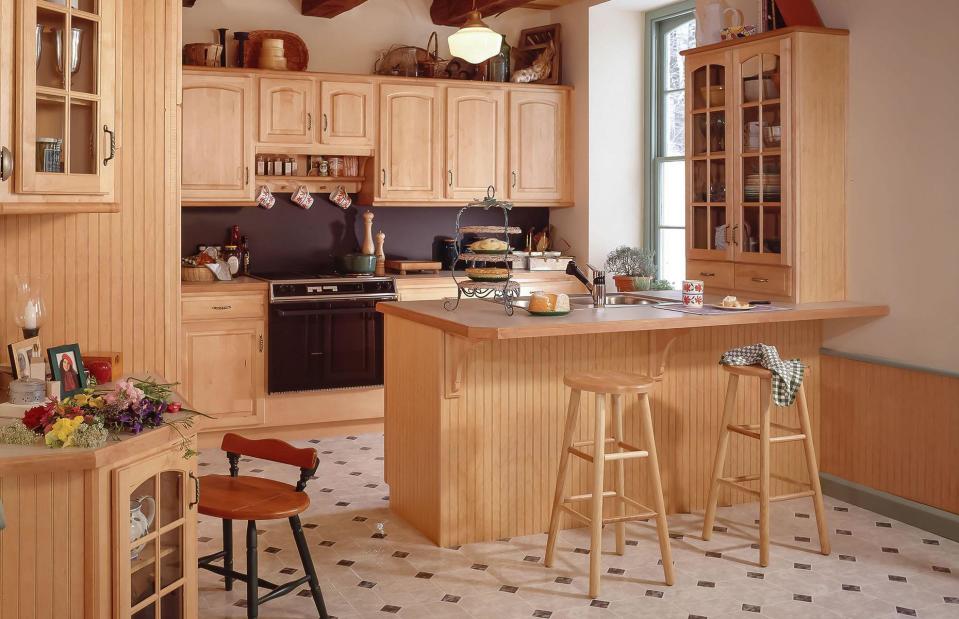
TOLBERT PHOTO / Alamy Stock Photo
While country kitchens were still popular, they began to shrug off their fussy style and adopt cleaner lines. Granite countertops were also in high demand.
Beige was big. Often referred to as Tuscan style, the colour was used everywhere from exterior render to kitchen cabinets.
1990s: the living room
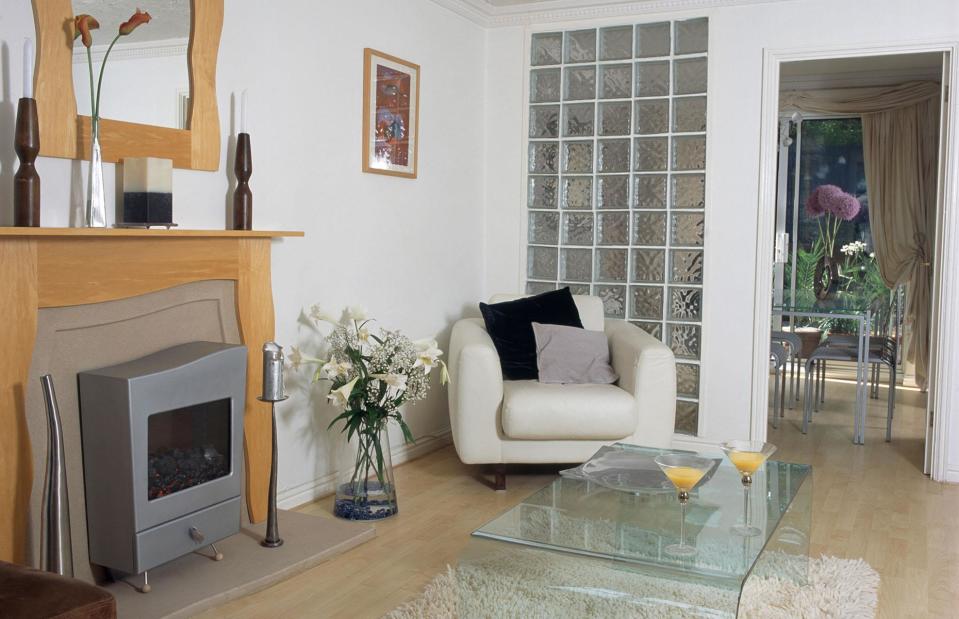
Elizabeth Whiting & Associates / Alamy Stock Photo
IKEA was founded in Sweden back in 1943, but it really took hold in a big way in the 1990s. Barely a sitting room existed without pale pine or black ash furniture, and everyone seemed to have the same sleek vases and candle holders dotted around their home.
Minimalism ruled, as did vaguely industrial-style furniture on casters. Blue, white and silver colour palettes were popular, but softened by pine, hints of rattan, ivory pillar candles and the occasional bright cushion.
1990s: the bathroom
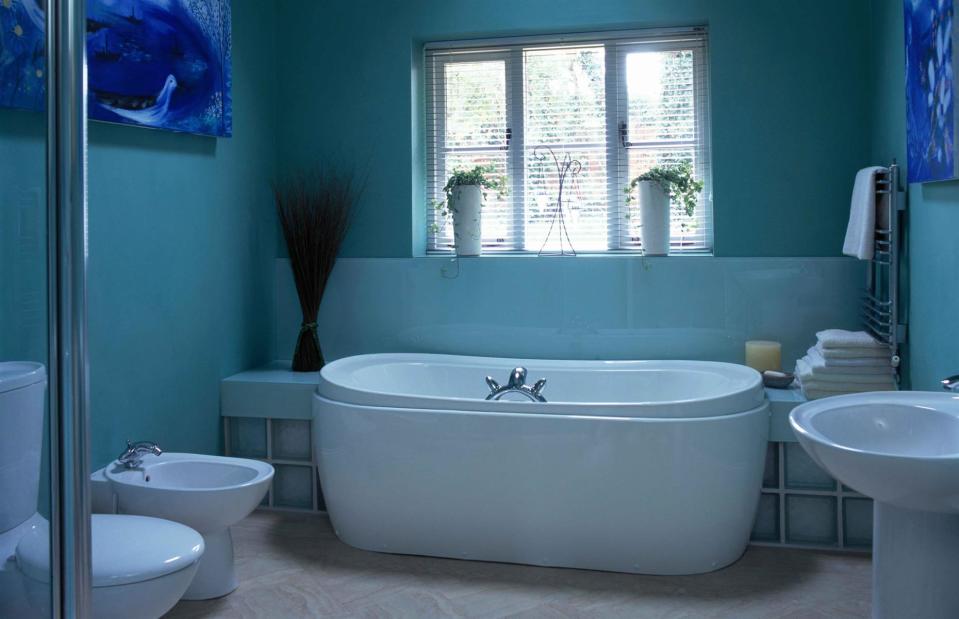
Elizabeth Whiting & Associates / Alamy Stock Photo
By the mid to late 90s, brass bathroom hardware had given away to polished chrome. Showers were increasingly favoured over baths, but all bathroom fixtures had to be of a sleek, simple design and sparkling white.
Neutral colour palettes and calming aqua tones like teal were favoured, reflecting a desire for a tranquil, almost spa-like bathroom environment.
1990s: the bedroom
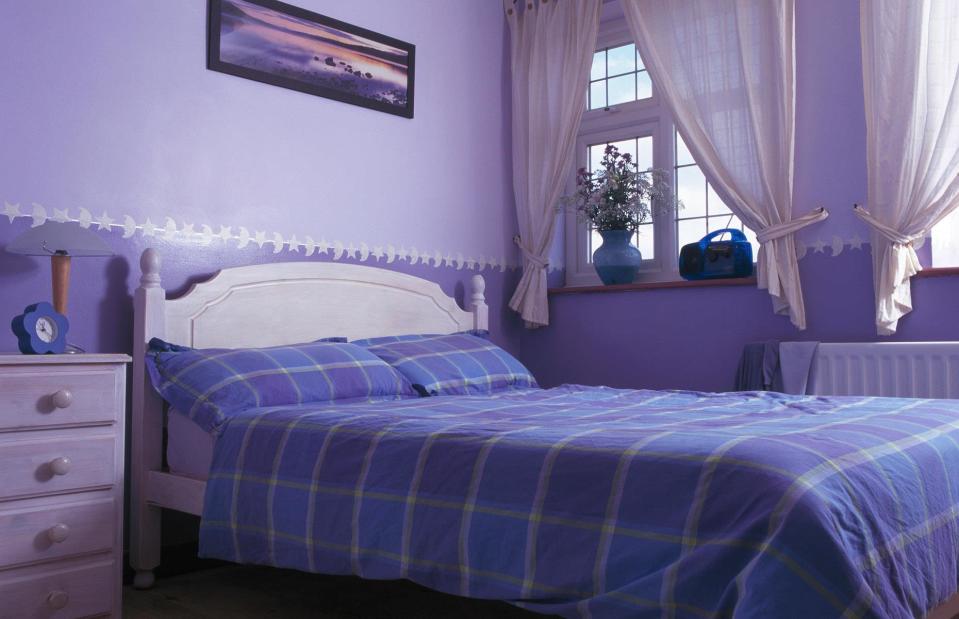
Elizabeth Whiting & Associates / Alamy Stock Photo
Inexplicably, purple bedrooms were wildly popular during this decade. If you didn't have various shades of mauve and lilac on your walls, along with wispy curtains, inspirational prints and a good old IKEA bed and nightstand combo, did you even live through the 90s?


